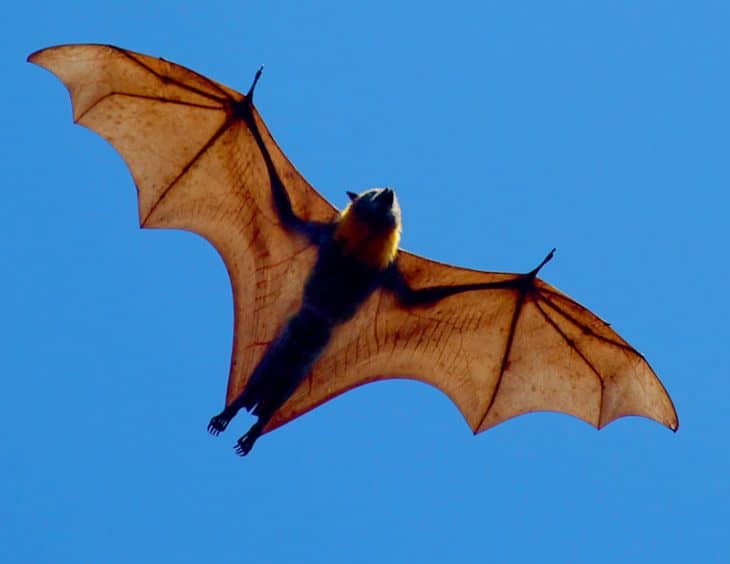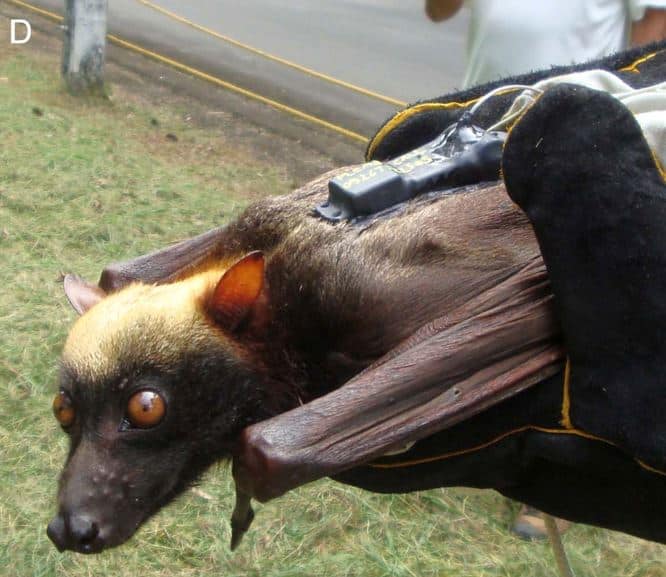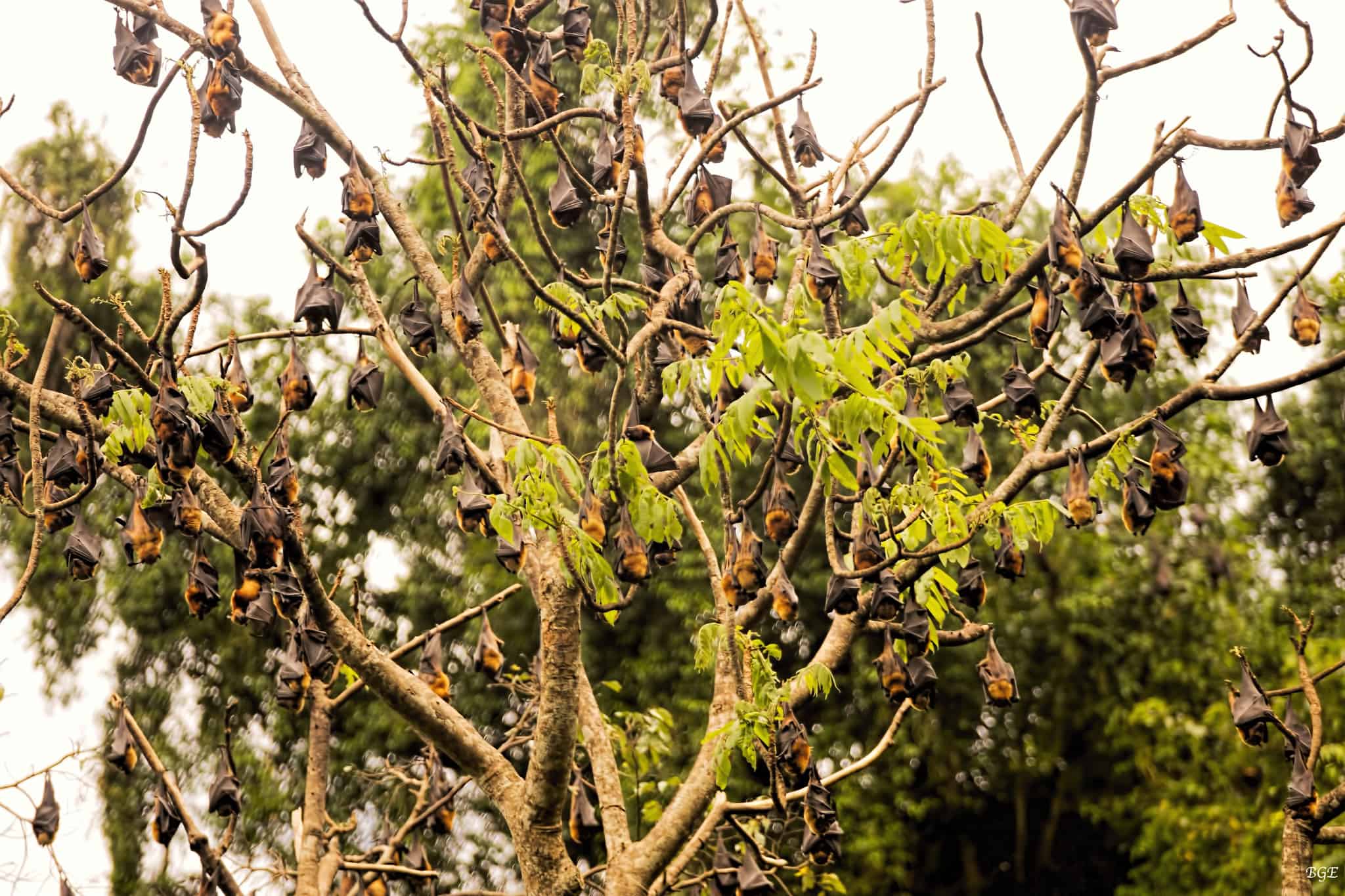
With wings that span up to 5½ feet long, the giant golden-crowned flying fox is the largest bat in the world. Flying around in the forests of the Philippines, this giant fruit-eating bat is definitely a sight to behold. Rare and elusive, this majestic megabat is mysterious, but it’s not as spooky as its appearance may suggest. Find out more about this fascinating animal with these facts about the giant golden-crowned flying fox.
- The German naturalist Johann Friedrich von Eschscholtz first described the species in 1831, where he classified it as Pteropus jubatus.
- They were placed in the newly-described genus Acerodon in 1837.
- At 8.5 in (21.5 cm), these bats have the longest recorded forearms of any living bat species.
- The giant golden-crowned flying fox has two living subspecies and one extinct subspecies.
- One of its subspecies, A. jubatus lucifer, has gone extinct and was last recorded in 1892.
- The giant golden-crowned flying fox is mainly nocturnal.
- This massive bat is also referred to as the golden-capped fruit bat.
- Like most bats, they sleep upside down.
- They are fruit bats native to the Old World.
- The scientific name of the giant golden-crowned flying fox is Acerodon jubatus.
- Babies of this species are altricial and unable to feed or care for themselves.
- The babies of this species are referred to as “pups.”
- Giant golden-crowned flying foxes are polygynous; males of this species mate with multiple females.
- They thrive in tropical environments.
- A group of golden-crowned flying foxes is called a colony, flock, or cloud.
- The giant golden-crowned flying fox belongs to the family Pteropodidae, or megabats.
- These bats do not have tails.
- The males of this species sometimes engage in self-pleasure, in which they continuously lick their own genitals for more than a minute.
- This species exhibits a slight sexual dimorphism: males are larger and heavier than females and have slight differences in the size of their skull structures.
- The now-extinct Panay golden-crowned flying fox (A. jubatus lucifer) was commonly thought to be a separate species, but scientists found that they were only a subspecies of the giant golden-crowned flying fox.
The giant golden-crowned flying fox is the largest bat in the world.
Like their name suggests, giant golden-crowned flying foxes are much bigger compared to other bats. However, the golden-crowned flying fox is not human-sized, contrary to popular belief. Instead, they have short, streamlined bodies that reach up to 7 to 11.4 in (17.8 to 29) cm long.
That said, their wingspan does tend to reach human-sized proportions. The golden-crowned flying fox has a large wingspan that can reach 5.5 ft (1.7 m). This gigantic wingspan led experts to believe that the giant golden-crowned flying fox is the largest bat in the world. As with all bats, their membranous wings lack any fur.
When it comes to weight, these megabats are not the heaviest bats in the world. The great flying fox (Pteropus neohibernicus) and the Indian flying fox (Pteropus medius) both outweigh the giant golden-crowned flying fox. Giant golden-crowned flying foxes weigh up to 2.6 lbs (1.2 kg), while great flying foxes and Indian flying foxes weigh up to 3.2 lbs (1.45 kg) and 3.5 lbs (1.6 kg) respectively.
They are built for sustained flight.
As with other megabats, giant golden crowned flying foxes have numerous adaptations that help them in flight. Since sustained flight requires a lot of energy and resources, megabats evolved with impressive adaptations in their cardiovascular systems. These adaptations include large lung volumes, fast heart rates, and a fast oxygen consumption rate.
This unique biology allows giant golden-crowned flying foxes to fly for long periods of time over large distances. On average, they can fly up to 25 miles (40 km) in a single night while foraging for food.
The giant golden-crowned flying fox can only be found in the Philippines.
Native to the Philippines, the giant golden-crowned flying fax cannot be found anywhere else in the world. In fact, this animal made history as the first endemic species of the Philippines ever described. People have documented giant golden-crowned flying foxes in the Philippine islands of Batanes, Cebu, Bohol, Boracay, and Palawan. Unfortunately, their population in Panay had been extinct since the late 1800s.
Golden-crowned flying foxes live in forests.
As a forest specialist, this bat species prefers to live in large primary forests and mature secondary forests. They typically live in elevations from sea level to 3,600 ft (1,100 m).
These megabats also choose to roost on small, offshore islands, mangrove forests, bamboo clumps, and swampy forests. They also like living near riparian zones or river corridors where there is an abundance of food and specific plant communities. Although they prefer to roost in undisturbed areas, they may sometimes live near human habitats and forage in agricultural fields and disturbed forests. However, they mostly just forage in these areas when crossing between undisturbed forested areas.
They get their name from their visual similarity to foxes.
Perhaps one of the most obvious giant golden-crowned flying fox facts is that despite their name, they are not foxes. As previously mentioned, they are the largest bats in the world. Bats belong to the mammalian order Chiroptera, while foxes belong to the order Carnivora.The term “flying fox” generally refers to the megabats of the family Pteropodidae. These bats adopted the name because their heads resemble those of foxes.
The golden-crowned flying fox specifically is named after its fur coloration. On the top of their heads, they have a crown-like golden-yellow fur. On other parts of their bodies, their fur’s colors range from maroon, dark brown, and black.

The giant golden-crowned flying fox is a frugivore.
While they have a menacing, vampire-like appearance, golden-crowned flying foxes are actually gentle, plant-eating giants. As a primarily frugivorous species, they mostly eat fruits.
Their diet mostly consists of figs (Ficus), with fig seeds making up around 41% of their droppings. Generally, the fig species Ficus subcordata makes up the bulk of their diet, but they also consume a wide variety of other fruits in lowland forests. Giant golden-capped fruit bats also sometimes eat leaves, which they would often crush to swallow the sap.
The golden-crowned flying fox does not use echolocation.
Nearly all megabats do not possess the echolocation ability that many other bat species have. As frugivores, golden-crowned flying foxes do not need this ability to locate their food. Instead, they rely on their keen senses of sight and smell.
That said, the phrase “blind as a bat” does not hold true with the largest bat in the world. They have large, brown eyes that help them navigate through the night sky. This species has a poorer eyesight than humans in daylight, but they have a better vision than humans during the night. Meanwhile, their sense of smell rivals the highly-developed sense of smell of domestic dogs, which they use to locate their meals.
Snakes, birds of prey, and humans are their natural predators.
Given their intimidating size, these megabats do have natural predators in the wild. Several large animals prey on this species, such as the massive Philippine eagle, red-backed sea eagle, and white-bellied sea eagle. During their roosting periods, reticulated pythons would also try to hunt them.
Like most bats, they play an important role in the ecosystem.
Bats play an important role in ecology, such as getting rid of pests and pollinating flowering plants. As such, scientists refer to bats as “keystone species”. Without them, the local ecosystem will most likely suffer a severe negative impact.
The golden crowned flying fox is no exception, because they disperse the seeds of the fruits they eat. As they travel long distances, they spread the seeds through their droppings. Their existence consequently ensures that the forests they inhabit have a healthy population of fig trees and numerous other plant species.
Giant golden-crowned flying foxes engage in multiple social behaviors.
To socialize, this bat species usually engages in mutual grooming and play-fighting. Experts believe that mutual grooming helps them get rid of parasites, letting the bats recognize their group members and enhancing their social bonds. Meanwhile, play-fighting involves mock-wrestling and mock-biting another bat, which typically occurs in young males.

Giant golden-crowned flying foxes often roost with other bat species.
This bat species has been observed sharing roosts with the Malayan flying fox (Pteropus vampyrus) and the small flying fox (Pteropus hypomelanus). Living together in large roosts helps protect all of these bats from potential predators.
From the early 1900s to the 1920s, there have been records of shared colonies that had up to 100,000 to 150,000 individuals. The other species usually outnumber the golden-crowned flying fox populations in these shared roosts. Giant golden-crowned flying foxes generally make up less than ⅕ of the shared roost population.
Although they share the same areas with other bat species, they tend to segregate themselves according to species. Scientists suggest that the said segregation according to species helps mitigate interspecies conflict and competition.
The giant golden-crowned flying fox has a distinct odor.
Giant golden-crowned flying foxes have a notably strong odor which suggests that they may use smell to communicate with others of their kind. Interestingly, however, scientists could not find any specific scent glands in the species.
Giant golden-crowned flying foxes take frequent baths.
The largest bat in the world often lives near river corridors, often taking dips in the water to groom themselves. To bathe, they scoop water up and spread it all over their bodies using their large wings.
They spend most of their time asleep.
In a scientific study of these giant bats’ daytime habits, researchers found that the golden-crowned flying fox spends more than 76% of its day sleeping. They often sleep on cliff edges, steep slopes, or hardwood trees. The females spend more time resting than males; the males spent more time engaging in behaviors that increased their opportunities to mate.
When they were not sleeping, the bats mostly spent the remainder of their time flapping their wings, grooming, and relaxing.

They potentially carry infectious diseases.
As with most bat species, giant golden-crowned flying foxes could potentially host a number of viruses such as Reston virus (RESTV), a type of Ebola virus. In 2008, the virus affected domestic pigs in the Philippines, as well as some hog farmers.
Although the hog farmers were asymptomatic and largely unaffected, the cases caused a significant level of concern regarding animal-to-human transmission of deadly viruses.
Golden-crowned flying foxes reproduce around the same time.
Because the golden-crowned flying fox is relatively rare, there is currently little knowledge regarding their reproductive behaviors. They often reproduce around the same time in their regions, suggesting that they breed seasonally and use photoperiods to signal when it’s time to breed. Typically, these bats often give birth from April to May, with some colonies giving birth between May and June.
They reproduce and mature fairly slowly.
These large bats reproduce fairly slowly, with captive individuals giving birth every two years at most. In the wild, they likely reproduce less frequently, contributing to their rarity. On average, they only give birth to one pup at a time. The bats also mature quite slowly, with females taking about two years to reach sexual maturity.
They fan their babies using their wings to keep them cool.
At birth, the helpless pups cling to the fur of their mothers using their claws. The mothers are solely responsible for the nourishment and care of their pups, even fanning the pups with one wing to keep them cool.
The giant golden-crowned flying fox is an endangered species.
These mega-sized bats were once common, but their populations have dwindled drastically due to deforestation and poaching by humans. Today, only a small percentage of their native forests remain, severely affecting the bats’ populations.
Their large sizes and tendency to live together in colonies make them easy targets for local hunters even despite conservation efforts. Oftentimes, hunters kill 20 to 30 individuals and sell what they retrieve as bushmeat. Currently, the IUCN Red List classifies these bats as endangered under the threat of extinction.
Some organizations work hard to preserve the populations of the largest bat in the world.
The rare giant golden-crowned flying fox is a spectacle to behold, and local wildlife enthusiasts greatly value their existence. Some locals also benefit from them attracting tourists, and therefore seek to protect the remaining populations of these rare and precious giant bats. Both local and international organizations now strive to protect their roosting grounds from poachers and illegal loggers.
Was this page helpful?
Our commitment to delivering trustworthy and engaging content is at the heart of what we do. Each fact on our site is contributed by real users like you, bringing a wealth of diverse insights and information. To ensure the highest standards of accuracy and reliability, our dedicated editors meticulously review each submission. This process guarantees that the facts we share are not only fascinating but also credible. Trust in our commitment to quality and authenticity as you explore and learn with us.
